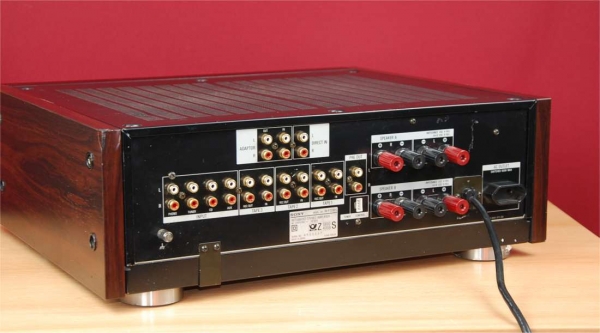Beneath the flap are, left-to-right, a standard 6.35mm (1/4-inch) headphones socket, an output switching control (one or two pairs of loudspeakers/headphones/preamplifier section output), Bass and Treble controls, Mono/Stereo and Subsonic filter, Direct input, Balance, Record Output selector and Cartridge Load (set-up for moving-magnet or moving-coil cartridges, with two loadings for MC: 40 ohms or 3 ohms).
At the rear are 14 pairs of goldplated phono sockets for the various inputs and the three record outputs, four pairs of 4mm socket/binding posts for the loudspeaker outputs, a ground screw for the pickup arm earth, a special four-pin "Control S" socket which permits operation of an appropriately appointed Sony tuner from the RM-S703 remote control (which will additionally operate other Sony equipment such as a DAT recorder and CD player), and a switched two-pin IEC mains outlet. As supplied, shorting plugs are fitted to the phono input sockets and should be left in place if an LP front end is not required.
Internally the TA-F770ES is most impressively built, with three main circuit boards (two for the input and signal processing-RIAA gain and EQ, tone controls, subsonic filter etc. - and one for the power amplifier stage) plus a number of ancillary ones for the control circuits. The overall component count is high but the majority has to do with this electronic 'housekeeping'. The mains transformer is a massive, metal encased unit which feeds two pairs of reservoir capacitors for the separate supplies, as outlined above. The array of pre-driver and output transistors is mounted on a large heatsink which runs the depth of the cabinet and plays the additional role of shielding the sensitive input circuitry from the power amplifier. The base and lid are heavily slotted to allow the free passage of air, which is very necessary as a good deal of heat is generated even with the amplifier idling. Compared with the norm these days there is quite a lot of point-to-point wiring, but all of this is very neatly laid out.
How it performed
On the test bench the TA-F770ES returned a fine set of the standard results. I was particularly impressed with the close tolerance of the RIAA equalization, which is as accurate as I have seen (the IEC-recommended additional LF pole is implemented). Even the calibration of the volume control was remarkably true, which is almost unique in my experience-commonly such labels are little more than cosmetic. On the review sample the Mute button actually dropped the level by 21dB rather than 20dB but that is an irrelevant error given its purpose.
I was very pleased to see the sensibly small range of the tone controls, specified at ±7dB at 100Hz and 10kHz for bass and treble respectively (which ties-in with my measured ±5dB at 160Hz and 8kHz). Few people these days need a wider spread than this and it should encourage the application of subtle tonal adjustments to slightly dull or overbright recordings, sure in the knowledge that however far one turns a knob nothing overly drastic is being administered beyond the frequency area of interest. For purist listening one would switch to Source Direct, certain now that the signal path is tonally flat and as accurate and 'clean' as can be; given a good recording this would certainly be the preferred setting and a marginal improvement in clarity can, I think, be detected.
The LP input is as good sounding as its response implies: crisp, detailed, firm, with very, very quiet levels of background hiss and hum. Compact disc is the most analytical signal source in the domestic environment these days of course and I'm pleased to report here too a tight, well controlled image-detailed and very 'capable' on transients with a full and positive bass. The extreme treble is very open, which may exacerbate any similar effect in loud speakers with a tendency to stridency (one or two metal dome tweeters come to mind) but as always, given suitably matched ancillaries (and in this regard a pre-purchase audition is strongly recommended) the TA-F770ES will do all one can ask and more, and at £599 represents very good value for money.
